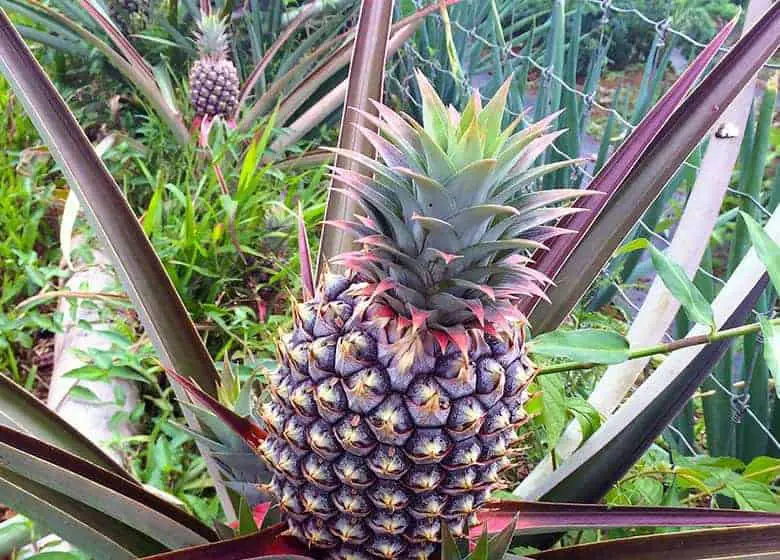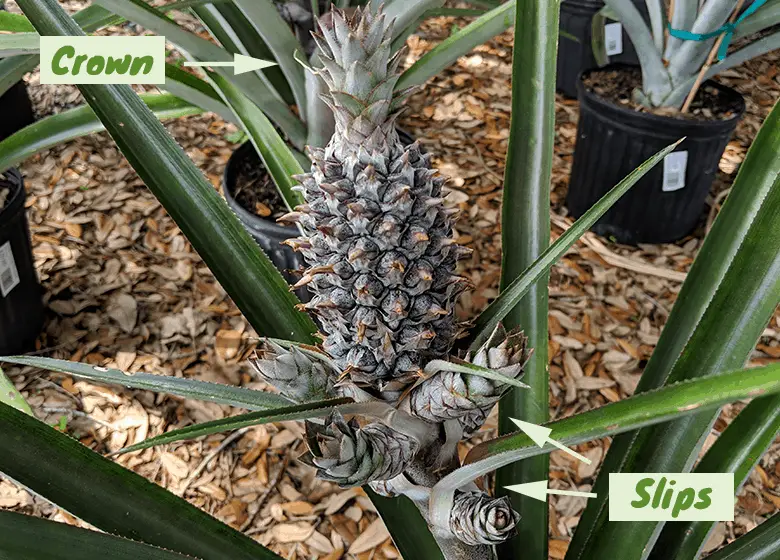What is your favorite way of enjoying your pineapples? In pizzas? As a fruit juice? But can you grow pineapples in Florida?
Yes, Pineapples are super easy to grow in Florida. Pineapples enjoy warm weather and they don’t need
Pineapples have been grown in Florida as far back as the 1800s before Hawaii was even part of the US territory (admit it: we think of Hawaii when we think of pineapples).
There are many varieties of pineapple that will thrive in all parts of Florida.
What Varieties Of Pineapple Grow In Florida?
- Red Spainsh
- Del Monte Gold
- Queen
- Sugarloaf
- Smooth Cayenne
The ‘Red Spanish’ is the more widely available variety of pineapples in Florida. They’re stumpier, too. Other varieties are D-2’ (or Del Monte Gold), ‘Queen’, and ‘Sugarloaf’, and the ‘Smooth Cayenne’.

The rounder and taller varieties, the ‘
When Do You Plant Pineapples In Florida?
North and Central Florida is mostly humid and subtropical. Southern parts of Florida have a tropical climate. The entire state is almost all favorable in terms of growing pineapples. With the exception of North Florida during the winter time.
The optimal temperature in which they thrive is between 68° F to 86°F.
We must consider our rainy summers and late springs.
It is important for you to know that pineapples actually do not like the wet season. This is why the soil in which they’re planted in is well-drained and not muddy or else their roots may rot.
And then if this happens, their fruit follows the rotting process as well, especially if the high water levels in the soil is not resolved.
The ideal time for you to plant pineapples in Florida is the early
Fall time. This gives you weather that is warm enough and dry enough for the plant to establish healthy roots and be off to a good start.
The Southeast and southwest of Florida will have the easiest time growing pineapples.
Do Pineapples Grow From Seeds?
If your on your way to asking whether they can be grown from their seeds, the answer to that is: YES
However, this is not the most common method of propagation.
The more common methods we can use are the crowns, suckers, or the slips.

The crown, as we all may know well, is the top part of the fruit with the leaves.
The suckers are the tiny ones in the base of the leaves, being left on the plant after harvest to grow into a usable size.
The ratoon referred to as the ‘second fruit’, or the slip is found below the fruit. This is also left after harvesting to be allowed to grow, resulting in the continuous production of new fruit.
The easiest way to grow a pineapple is to simply plant the head of the pineapple from a grocery store right into the ground. It’s most
Best Soil For Pineapples
Pineapples grow best on a sandy loam type of soil.
Crazy, right?!
Pineapples need a well drained soil because they do not like their feet being wet for too long. You can plant right into your soil if you would like but If definitely wouldn’t hurt to add some compost and mulch to your soil.
Whenever I plant I always like to make a mix that looks something like this:
- 40% Peat moss (Check price on Amazon)
- 40% Compost (You can get it on Amazon but I’ve found it way cheaper at local stores)
- 20% perlite (Check price on Amazon)
- Worm castings (Check price on Amazon)
- Mykos (Check price on Amazon)
Planting Pineapples
The first, most crucial step of growing a productive pineapple plant is selecting a good site for planting it.
Pineapples need full sun in order to thrive. Anything less than 6 hours per day and you probably won’t see much of a harvest. Be sure to observe the
Distances between two neighboring pineapples should be from 1 to 3 feet. Just like any other plants, widely-spaced plants allows for good plant nutrition and results in larger plants.
But pineapples have been known to grow really well in large groups. Although I have never tried this method, I have seen it online in a few places.
Single pineapples can still definitely be grown.
But for a single pineapple, fortunately, they can be grown in pots, as well. One good thing about pineapple is that it has a shallow root system, thus, pot-planting them would be a non-issue.
Generally, new plants are even kept in a reasonably spaced container until roots are established before being planted in larger containers or a larger open garden area. It should take about 6 to 8 weeks for roots to develop.
Do I need To Prune A Pineapple?
There is no need for leaves to be taken off the pineapple plant during fruit development.
Just one thing, since they can be spiky, situate them in a place where they won’t accidentally pierce anything or anyone. However, for some parts, such as suckers,and slips removing them may quicken fruit growth.
Fertilizing
Fertilizing your pineapples will help you have happier plants. If you’ve seen fertilizers at the store you’ve most likely noticed three numbers on the bag.
These are the Nitrogen(N), Phosphorous(P), and Potassium(K). Pineapples do well with fertilizers that are heavy in nitrogen for the first half of it’s life.
Nitrogen, helps the plant produce green leafy growth. The first half of the pineapple’s life is dedicated to growing green leafs. As it is ready to produce fruit, phosphorous becomes more important.
Phosphorous is important to flower and fruit production. Potassium is good for the overall health of the plant.
I would start fertilizing my plant with a nitrogen-heavy fertilizer like fish fertilizer(Check price on Amazon). And then before it begins to fruit I
Pineapple Pests And Diseases
- Nematodes
- Mealy Bugs
- Scales
Nematodes in soil feeding on plant roots.
Nematodes are hard to get rid once the soil is infested prior to planting, so the best way to avoid this is the use of clean soil before planting anything in it.
Root rots are signs of possible underlying disease. The common disease-causing organisms are the Pythium species. Plant death that arose from earlier reduced plant growth and browning of leaf margins is the hallmark of this. One good way to avoid the common pineapple disease is to avoid long exposure of the roots to excessive moisture.
How Long Does It Take Pineapples To Ripen
Depending on cultural practices, temperature and other significant factors as such, a pineapple can be harvested approximately 18 to 24 months from planting.
Fruit sweetness is optimal when 2/3 of the pineapple peel has turned from green to greenish-yellow.
You’ll then have to wait up to 6 months for this fruit to mature. So
Growing Pineapples In Florida
Here are a few things you should keep in mind when growing a pineapple:
- It’s undeniably a sun-loving fruit. Caring for it would mean a lot of sun exposure and that it’s kept in the warmest weathers.
- Pineapples are not a big fan of water. Flooding soil conditions would figuratively drown them then rot them. So don’t keep them wet for too long!
- The easiest way to plant a pineapple is to plant the crown. Just save the top from
one you bought at the store. - Plant it shallow.
- Don’t expect much from it in its early few months. As said, it usually takes 18 to 24 months for a plant to start producing fruit.
- Okay. So much of the words. Let the action begin. Best of luck on your first pineapple harvest!
